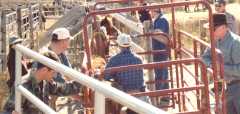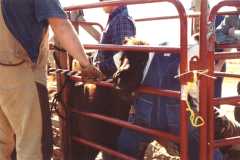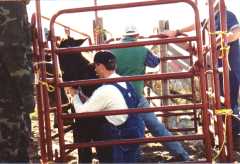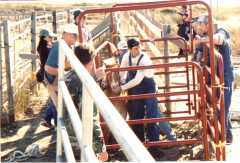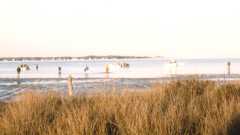CAPE LOOKOUT NATIONAL SEASHORE, NC
The ATV drivers mounted up and ran back along the ocean shore toward the west. The last of the "wild bunch", a young stallion named Slash, was still at large. The plane was back in place over the maritime forest; the Special Forces men and several other walkers with radios were infiltrating the forest and its bogs; and the sun was getting low in the sky on this sunny, seventy-degree January day. Those of us back at the horse pens were listening to the activity via radio, as Slash was spotted, lost in dense forest, spotted at the dune edge, or seen near the sound shore. We were getting a bit tense, as there were only a couple of hours of daylight left, and this particular young stallion had proven himself to be lightning-quick at evasion maneuvers. These horses know every tree, pond, dune, and blade of grass in their territories, and they can spin around and run in a heartbeat. They are also good at hiding in the forest, as they stand motionless and watch you pass them by. Several walkers recounted times that they were laboriously making their way through briars and trees looking for horses, when they glanced to the side and saw a horse watching them! As the sun was beginning to set, Slash made his run to the beach, and the ATVs got behind him. Good as he was, the young stallion didn't yet have the stamina of Lenon, so the trip to the east wasn't quite as fast. Again, the drivers took their cue from the horse as to how the trip would be made. When they radioed that they were bringing Slash down the beach, those of us at the pens took our places at the end of the ocean-side lead. As the stallion saw us blocking his way ahead, he began turning his head to check out the exact locations of the ATVs off to his left. He moved toward the driver nearest his left, then eased right toward the ocean. The driver slowed down and moved toward the ocean, too. Slash then dug in his hooves, and with a burst of speed spun left, up to and over the oceanfront dune. The drivers gunned their vehicles and a couple of them managed to stay to his left as he headed toward the corral. Realizing he couldn't bolt back toward the west, Slash made the right-hand turn into the large outer pen and ended his flight as he reached the far corner of the enclosure. As Lenon had done previously, the young stallion grabbed a mouthful of hay, and began looking around. There were grins on every exhausted face now that the last horse was safely in. With darkness falling, the drivers secured their vehicles; the walkers gathered their belongings; everyone put on his boots, and all but those spending the night on Shackleford started wading out to the boats to go back to the mainland for a well-deserved rest. | |||
|
By late afternoon, the last horse, a foal named Larry, (nicknamed "Sunshine" by the Special Forces men because of his golden color) was through the chute. One thing I found interesting was that the most dominant stallions - the strongest, most feisty and most likely to raise a ruckus usually stood rock still in the gates, just arching their necks and slowly turning their heads to glare down at the vet (who had to lean away several times to avoid bites). When I commented to Dr. Tickel, he said, "With these guys it's all testosterone. As long as they can look down at me, they're O.K." Everyone left for the mainland except Margaret and me, as we were staying overnight. Dr. Issel was going to start running his tests at the NPS building at Harkers Island, assisted by Foundation director Anita Kimball; Dr. Tickel and the handlers left to deliver samples to the state lab in Raleigh. About nine o'clock that night, when we hooked up a cellular phone to a battery to call the mainland, we were told the news: Dr. Issel's tests results were complete: NO POSITIVE HORSES. We were elated!! We whooped and gave thanks, and celebrated with canned meat, crackers and ice-less sodas. The relief, even though the "official" results were not in from Raleigh, was indescribable. On Thursday, 24 January, friends who were staunch supporters of the wild horses, came over to visit, share the good news, and watch the horses as they interacted and munched on hay in the pens. It was a glorious, summer-like day, with a soft breeze wafting off the glistening Atlantic Ocean. On Friday, 25 January, the official word came in from Raleigh: there was no virus among the horses. We placed some hay outside the pens and opened the gates to let the horses leave at their own pace. Several horses noticed the open gates and the hay and began leaving the enclosures. Within minutes, some of the stallions looked towards the west and called to the others; then, the horses began their run back to freedom. It was a moving and memorable moment as we watched them fly away with their manes in the wind. This may well be the last total roundup of the Shackleford Banks wild horses. As we carried our belongings to the Back Sound shore to board the boats, a mare and her foal hesitantly passed, having turned from their westward dash to return to their home territory east of the horse pens. It was a good feeling as we sped across the sound toward the mainland in our small boats, to know that everyone had done their best, and that the wild horses of Shackleford were once again free on their ocean island. |
The horses were moved into a chute from the pens in the rear.
After having blood drawn, they were released into the large pen on
the right.
| ||
